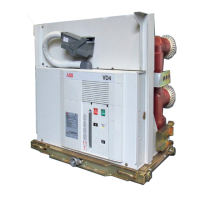8. Putting into service
8.1. General procedures
All the operations regarding putting into service
must be carried out by ABB personnel or by
suitably qualified customer personnel with in-depth
knowledge of the apparatus and of the installation.
Should the operations be prevented, do not force
the mechanical interlocks and check that the
operating sequence is correct.
The operating forces which can be applied for
racking-in withdrawable circuit-breakers are
indicated in paragraph 7.5.
Before putting the circuit-breaker into service, carry out the
following operations:
– check tightness of the power connections to the circuit-
breaker terminals;
– establish the setting of the primary electronic overcurrent
release (if provided);
– check that the value of the power supply voltage of the
auxiliary circuits is between 85% and 110% of the rated
voltage of the electrical accessories;
– check that no foreign bodies, such as bits of packing, have
got into the moving parts;
– check that there is a sufficient exchange of air in the
installation place to avoid overtemperatures;
– also carry out the checks indicated in table T3.
T3
ITEM INSPECTED PROCEDURE POSITIVE CHECK
1
Insulation resistance.
Medium voltage circuit
With a 2500 V megger, measure the insulation resistance
between the phases and the exposed conductive part of the
circuit.
The insulation resistance should be at least 50
Mohm and in any case constant over time.
Auxiliary circuits
With a 500 V megger (if the apparatus installed allows this),
measure the insulation resistance between the auxiliary circuits
and the exposed conductive part.
The insulation resistance should be a few
Mohm and in any case constant over time.
2
Auxiliary circuits. Check that the connections to the control circuit are correct:
proceed at the relative power supply.
Operations and signals normal.
3
Manual operating mechanism. Carry out a few closing and opening operations (see cap. 6).
N.B. Supply the undervoltage release and the locking magnet
on the operating mechanism at the relative rated voltage
(if provided).
The operations and relative signals take place
normally.
4
Motor operator (if provided).
voltage.
The spring is charged normally.
The signals are normal.
With the spring charged, the geared motor
stops.
Carry out a few closing and opening operations.N.B. Supply the
undervoltage release and the locking magnet on the operating
mechanism at the relative rated voltage (if provided).
The geared motor recharges the spring after
each closing operation.
5
Undervoltage release
(if provided).
Supply the undervoltage release at the relative rated voltage and
carry out the circuit-breaker closing operation.
The circuit-breaker closes normally.
The signals are normal.
Cut off power to the release. The circuit-breaker opens.
The signalling changes over.
6
Shunt opening release and
additional shunt opening
release (if provided).
Close the circuit-breaker and supply the shunt opening release
at the relative rated voltage.
The circuit-breaker opens normally.
The signals are normal.
7
Shunt closing release
(if provided).
Open the circuit-breaker and supply the shunt closing release at
the relative rated voltage.
The circuit-breaker opens normally.
The signals are normal.
8
Key lock (if provided). Open the circuit-breaker, keep the opening pushbutton
depressed, then turn the key and remove it from the housing.
Attempt the circuit-breaker closing operation.
Neither manual nor electrical closing takes
place.
Put the key back in and turn it 90°.
Carry out the closing operation.
Both electrical and manual closing take place
normally; in this position the key cannot be
removed.
9
Locking electromagnet (-RL1)
(if provided).
With the circuit-breaker open, spring charged and locking
electromagnet not supplied, attempt circuit-breaker closing both
manually and electrically.
Closing is not possible.
10
Auxiliary contacts in the
operating mechanism.
Insert the auxiliary contacts in suitable signalling circuits.
Carry out a few closing and opening operations.
Signals take place normally.
11
Locking electromagnet on the
truck circuit-breaker (-RL2)
(if provided).
With the circuit-breaker open, in the isolated for test position
and the locking electromagnet not supplied, attempt racking-in
of the circuit-breaker.
Racking-in is not possible.
Supply the locking electromagnet and carry out the racking-in
operation.
Racking-in takes place correctly.
12
Auxiliary transmitted contacts
for signalling circuit-breaker
racked-in, isolated (UniGear
switchgear of PowerCube
modules).
Insert the auxiliary contacts in suitable signalling circuits.
With the circuit-breaker racked into the enclosure, carry out a
few traverse operations from the isolated for test position to the
connected position.
Take the circuit-breaker to the racked-out position.
The signals due to the relative operations take
place normally.
21
Supply the spring charging geared motor at the relative rated

